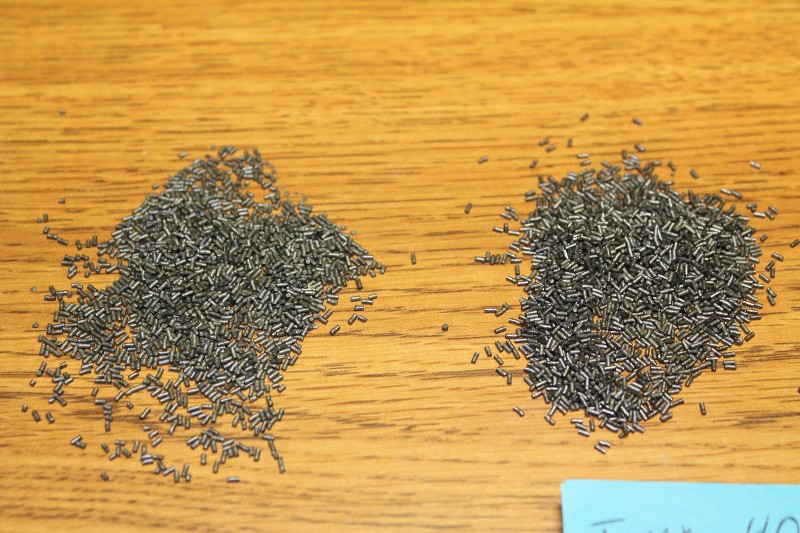Stats Shooter
New member
So I pulled some Federal Gold Medal match bullets to see what they are using in their 175 grain and 168 grain .308 loads. I pulled 4 of each to check consistency . I found the following.
Both 168 & 175
COAL 2.80 +/- 0.0015
Case Length : 2.0088 +/- 0.0010
FC case
Fed 210M primers
Bullets Sierra Match King BTHP
168 Grain
Base-Ogive: 2.2200 +/- 0.0010
Powder 43.5 Grains
175 Grain
Base-Ogive: 2.2300 +/- 0.0020
Powder 41 Grains
I have been informed that Federal GMM used to use IMR 4064 for both loads but switched at some point to RE 15. The military made them switch back to IMR 4064 due to temp sensitivity.
The Sierra manual says the max charge for IMR 4064 in 175 grain is 42.8, and in RE 15 it is 41.3...For the 168 grain load, Sierra says a max load of 4064 is 43.4 and for RE 15 the max charge is 43.6.
The question is: which powder is Federal using? Hodgdon says the max load of 4064 for 168 gr is 45.9(C) and 45.6(C) for 175 gr bullets. Lyman says the max is 44.8 and 44.3 gr RE 15 for 168 and 175 gr bullets respectively.
I guess it may not matter. I intend to use IMR 4064 and BR-2 primers so my load may be a bit different. I will update this thread tomorrow morning after I test the velocity for both bullets but that may not mean much given my AR-10 is obviously going to be different than anyone else's. Previous testing at 200 yards indicated my gun preferred the 175 grain bullets with groups under 3/4" at 200 yards. The 168 grain bullets were decent also grouping at 1.5-2" at 200 yards but not as tight, or consistent, as the 175 grain load....1:10 twist barrel
Update: 2391 FPS for 175 gr GMM at 40 degrees F (8 shot average)
2504 FPS 168 grain GMM...same conditions and 16.25" barrel
Box says 2600 for 24" barrel 175 grain
2650 for 168 grain
Both 168 & 175
COAL 2.80 +/- 0.0015
Case Length : 2.0088 +/- 0.0010
FC case
Fed 210M primers
Bullets Sierra Match King BTHP
168 Grain
Base-Ogive: 2.2200 +/- 0.0010
Powder 43.5 Grains
175 Grain
Base-Ogive: 2.2300 +/- 0.0020
Powder 41 Grains
I have been informed that Federal GMM used to use IMR 4064 for both loads but switched at some point to RE 15. The military made them switch back to IMR 4064 due to temp sensitivity.
The Sierra manual says the max charge for IMR 4064 in 175 grain is 42.8, and in RE 15 it is 41.3...For the 168 grain load, Sierra says a max load of 4064 is 43.4 and for RE 15 the max charge is 43.6.
The question is: which powder is Federal using? Hodgdon says the max load of 4064 for 168 gr is 45.9(C) and 45.6(C) for 175 gr bullets. Lyman says the max is 44.8 and 44.3 gr RE 15 for 168 and 175 gr bullets respectively.
I guess it may not matter. I intend to use IMR 4064 and BR-2 primers so my load may be a bit different. I will update this thread tomorrow morning after I test the velocity for both bullets but that may not mean much given my AR-10 is obviously going to be different than anyone else's. Previous testing at 200 yards indicated my gun preferred the 175 grain bullets with groups under 3/4" at 200 yards. The 168 grain bullets were decent also grouping at 1.5-2" at 200 yards but not as tight, or consistent, as the 175 grain load....1:10 twist barrel
Update: 2391 FPS for 175 gr GMM at 40 degrees F (8 shot average)
2504 FPS 168 grain GMM...same conditions and 16.25" barrel
Box says 2600 for 24" barrel 175 grain
2650 for 168 grain
Last edited:

